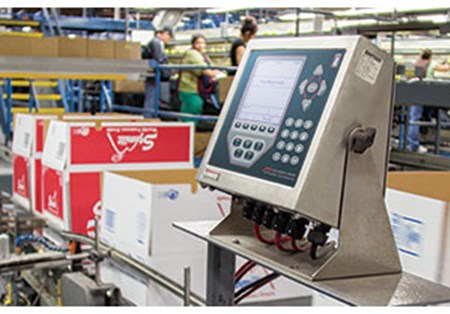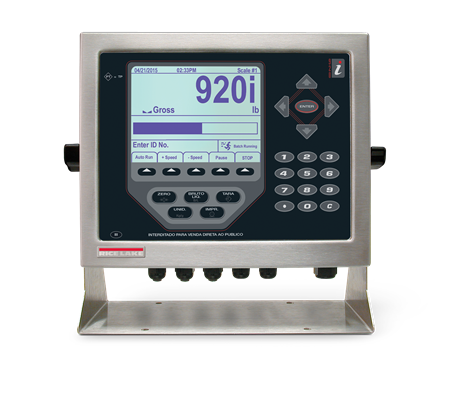Is the website displaying in the correct language? Please confirm or select a different language.
Your region has been set automatically. Please confirm or select a different region.

Red is Delicious
From picking to packing, fruit is measured, sorted and weighed by a variety of Rice Lake scales—providing the weighments needed to keep this family-owned company's operation running smoothly.
There is something special about Wenatchee, Washington. The Columbia River rushes like a vein through the charming small town, cutting an impressive valley into the surrounding snow-capped mountains. The sudden elevation change and abundant fresh water results in unique conditions that are perfect for agriculture. In this industry, as in real estate, it’s all about one thing: location, location, location. A family owned fruit company in this valley has reaped the rewards of this exceptional environment to grow world famous apples, cherries, and pears since 1964. From picking to packing, their fruit is measured, sorted, and weighed by a variety of Rice Lake scales, providing the weighments needed to keep the operation running smoothly.
Nick Arness is a full-time scale technician for this company, Stemilt Growers LLC. One look at any of their three facilities confirms the need for a permanent scaleman. At every turn, 920i® digital weight indicators, IQ plus® 2100 bench scales, CW-90X checkweighers, and custom fabricated in-motion checkweighers sprinkle the production floor. It’s like an enormous sports team taking the field: each member contributing to the end goal of delivering fast, highly precise weighments.
Stemilt harvests fruit from its own orchards, but also intakes nearby farms’ fruit into their production lines. “Those growers usually know what their crop weighs before they drop it off ,” Nick explains. “They’re weighing it out in the field and they demand that we have excellent equipment so they get paid for what they’ve worked so hard to produce. They come here because we have the best equipment and they get exactly what they have earned.”
The facility employs hundreds of 920i digital weight indicators to control multiple processes, which are different for each type of fruit. When an apple is first received, it is cooled, sorted, and pre-sized until it can be processed. Pre-sized apples are then loaded into bins, which have a tare weight stored in the indicator. The 920i scale indicator automates the process and stores data in Stemilt’s elaborate database, which assigns the weighments to the appropriate grower.
After initial weighment, apples travel through a series of elevated waterways which zig-zag past machinery and around corners. Watching the buoyant fruit take this joyride is like watching speedy gondolas navigate the canals of Venice, Italy. The apples pass through automatic color sorters, which use a high-speed imaging system to analyze the color and compare it to a standard for each variety. The color sorters assign a value to the apple so similarly colored apples can be grouped together and distributed as necessary into various packaging options. Apples which don’t meet minimum color requirements are typically used for juice or sauce while the upper echelon are kept in whole form.
Now sorted by color and size, apples continue their trek through Stemilt’s cutting-edge facility. Depending on whether they are to be sold in a mixed fruit bag, individually, or in larger quantities, they are delivered to those packaging lines. At this stage, apples pass along more Rice Lake scales—either CW-90X checkweighers, IQ plus 2100 bench scales, or 920i weight indicators mounted to custom fabricated in-motion checkweighers—and they all “talk” to each other. “Everything is networked,” Nick says. “Keeping track of the numbers is extremely important to measuring production and efficiency. What comes in, what gets scrapped, and what goes out in packed fruit gives us percentages that we present to the growers.”
Each apple is tested for ripeness, form, color, and sugar content. Any excess material (such as leaves or extra-long stems) is removed prior to the final weighment so Stemilt doesn’t pay for defects, known as culls. Growers are then paid based on quality and quantity, and detailed statements break down the results.
Apples are processed year-round, but cherry season has a smaller window, spanning the months of June through August. One might not know it by comparing the two fruits, but cherries are much more valuable than apples. Nick estimates that cherries average 7.5 cents per fruit, and when such high quantities are produced by Stemilt per season, there’s a great deal of money to be made in the cherry business with the proper equipment. Grams and ounces missed here and there add up to serious dollars, and Stemilt trusts Rice Lake to optimize their profits.
Where the apple process uses average bin weight for the tare, the exact tare weight of each bin is taken for every cherry weighment. After the bulk weight is captured, the bin dumps the fruit (controlled by the 920i weight indicators) and returns, at which point the empty bin weight is obtained and subtracted from the full weight.
The cherries are then transported via water passageway to bagging or boxing stations, where another weight is captured. Finally, they travel across another custom fabricated 920i in-motion checkweigher which scans the package’s barcode, references its database for the acceptable weight tolerance, and either accepts or rejects the container based on the live weight. If rejected, the cherries are weighed on static checkweighers and product quantity is adjusted until the proper weight is achieved.
Based on the information retrieved from the scales, Stemilt provides reports for cull percentage, undersize percentage, under-color percentage, scrap percentage, and packed percentage. “The growers really appreciate the detail we provide them,” Nick explains. “This is their livelihood and they want to know everything about the products they deliver. Rice Lake scales help us provide that information in incredible detail.”
Currently, the cherry checkweighers are a hodgepodge of equipment, but Nick plans on upgrading it all with Rice Lake. “We’ve already implemented CW-90X checkweighers and I really like them,” Nick explains. “The CW-90Xs are fast and durable. I haven’t had any problems with them, the operators like them, and the equipment interfaces with our systems seamlessly.”
Especially true for cherries, it is essential for all the systems to be integrated. Stemilt is a paradigm of sophisticated data acquisition, utilizing data from scales to its fullest extent. “We weigh everything,” Nick says. “Weights equal money, and our ownership is committed to getting the most accurate weights. We weigh at every opportunity because we want to ensure the farmers get precisely what they have earned, and don’t want to pay for anything but the actual fruit; no dirt, no water, no leaves— just the fruit.”
Because the cherry season is short, it is a time of frenzy. “It’s a mad dash during those months,” Nick says. “Our equipment is designated for cherries, so it rests for most of the year and it’s my job to turn everything on a few weeks before the season and make sure it’s working correctly. Other scales generally need more attention than Rice Lake equipment. As long as the Rice Lake scales are kept clean, I can just hook them back up, turn the systems on, and they’re good to go. They are much more reliable than other scales we’ve used.”
Although they are run at a different plant, pears follow a similar system to apples. However, because they are high-value, pears are subjected to full and empty bin weights and a culling process. The pear culling system also relies on 920i digital weight indicators to control the lines and Rice Lake Summit floor scales to weigh the bins. Each pear is sorted, sized, and color-graded.
Pristine pears progress through the numerous checks and balances, ending up in grocery aisles. Imperfect pears are grouped and used for juice, and scrapped pears are also recorded in the company’s database. At any point, each package can be tracked back to the grower. This is essential for accurate billing, and the powerful 920i is integral in obtaining this data.
“Everywhere you look, there’s a 920i,” Nick explains. “I’ve spent a lot of years in this business and I continue to choose the 920i because it’s so easy to work with. It’s fast, reliable, and flexible enough to handle anything I can throw at it.”
“At times, keeping track of all the scale equipment can be as challenging as maintaining it,” Nick continues. “There are so many scales that it would be like looking for a needle in a haystack if we didn’t have everything mapped out.”



From apples to cherries and pears, Stemilt produces some of the finest fruit in the world. The elaborate and prolific weighing systems throughout the company’s three facilities enable Stemilt to control processes that less efficient companies haven’t even dreamed of. Nick’s design and fabrication expertise, aided by a cutting-edge IT department, helped create a network of coordinated scales, capable of measuring success at every turn. Installing Rice Lake scales throughout the plant has allowed Stemilt to maintain a level of quality indicative of their delicious products.
When asked to compare Rice Lake equipment with other manufacturers’, Nick offers this definitive statement: “It’s like comparing apples and oranges. Rice Lake is the apple, and we don’t do oranges here.”
Subscribe to Rice Lake Magazine
Sign in or create a Rice Lake website account to request a Rice Lake Magazine filled with application stories like this one be sent to you.
Account Sign In Create an Account


 My Account
My Account








